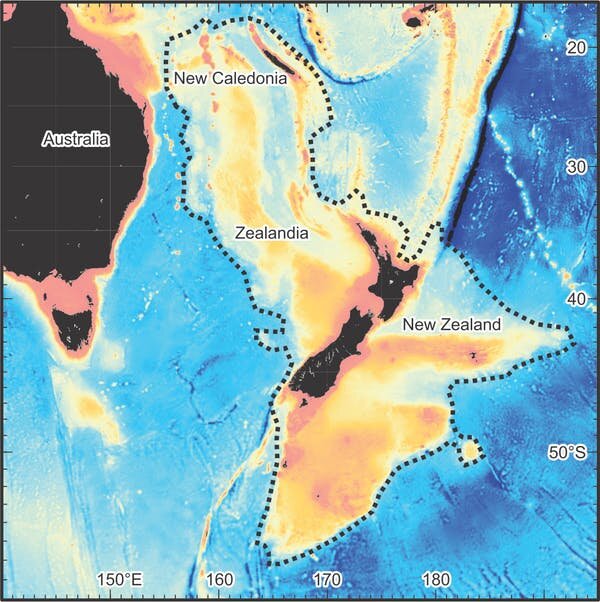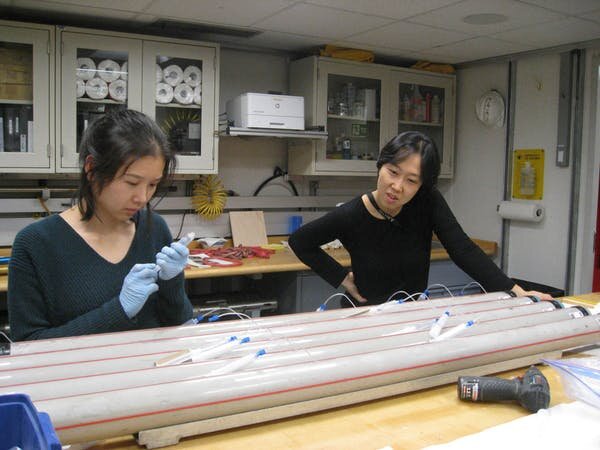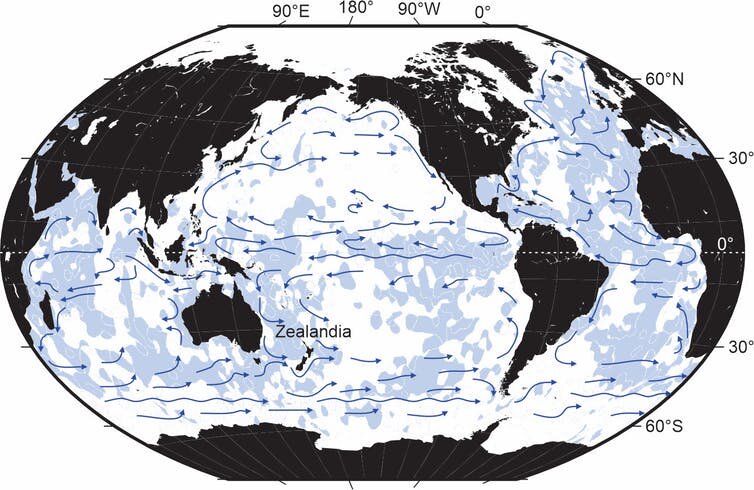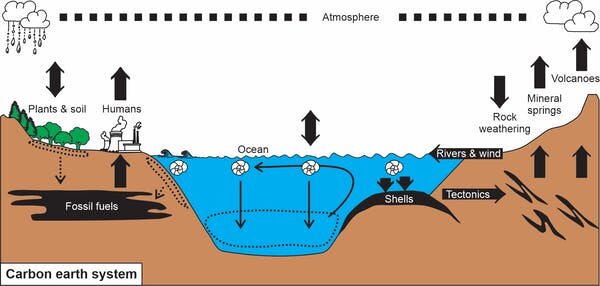 |
| The continent of Zealandia is about twice the size of India, but most of it lies more than 1000m deep in the southwest Pacific Ocean. Credit: Author provided, CC BY-ND |
We think of trees and soil as carbon sinks, but the world's seas have much bigger carbon reserves and are more effective at permanently storing carbon. In a new study published today, we look at the long-term rate of persistent carbon removal by plankton seashells in the ocean around New Zealand. We show that seashells have taken down roughly the same amount of carbon as regional CO2 emissions and that this process was significantly more intense during prehistoric eras of climatic warming.
Humans are removing carbon from the earth by burning fossil fuels that were deposited millions of years ago and releasing them into the atmosphere as carbon dioxide. The present pace of the generation of new fossil fuels is quite low. Instead, the production of seashells, which get retained as sediment on the ocean floor, is the primary geological (long-term) mode of carbon storage today. Zealandia is primarily submerged beneath the southwest Pacific Ocean, however, it does contain the islands of New Zealand and New Caledonia. Carbon dioxide emissions from the continent's use of fossil fuels amount to around 45 million tons per year or 0.12 percent of the world's total.
 |
| Researchers Xiaoli Zhou (US) and Yu-Hyeon Park (Republic of Korea) take samples of water from sediment cores during IODP Expedition 371. Credit: Laia Alegret, IODP, CC BY-ND |
Our work is documentation of a project that was a part of the International Ocean Discovery Program (IODP). Expedition 371 bore into Zealandia's seafloor to learn more about how the continent developed and to examine ancient environmental changes documented in its deposits. In both the ocean and forest soils, organic carbon in the form of dead plants, algae, and animals is mostly consumed by other species, primarily bacteria. The majority of creatures in the ocean are so minute (less than 1mm in size) that they are invisible, yet when they die and sink, they transfer carbon to the deep ocean. Their shells can build up on the seafloor, forming massive amounts of chalk and limestone. The sediments we cored were hundreds of meters thick and produced during warmer conditions similar to those expected in the coming decades and millennia. The examination of fossils has provided us with information about former habitats.
 |
| This map shows global ocean surface currents and regions of seabed (shaded) where calcium carbonate shells are accumulating. Credit: Rupert Sutherland, CC BY-ND |
Seashells, which are formed of calcium carbonate, absorb a large quantity of carbon. Over the last million years, the average accumulation rate of shells was around 20 tons per square kilometer every year. Because the Zealandia continent had a total size of around 6 million square kilometers, the average rate of calcium carbonate storage was approximately 120 million tons per year, which is comparable to 53 million tons of carbon dioxide per year. Within calculation uncertainties, this is almost the same as emissions from burning fossil fuels on the continent today. However, minute seashells are collecting in a much greater region than simply Zealandia.
As rocks boil deep, the Earth naturally releases carbon dioxide from mineral springs and volcanoes. Climate change is unlikely to have an impact on this. When rocks are transformed at the top and seashells collect on the seafloor, the Earth stores carbon dioxide. Climate change may have an impact on both of these mechanisms. The biosphere and oceans also contain huge carbon reserves, which will undoubtedly alter. It is a complicated system, and many scientists are attempting to figure out how it will react to human activity. Different components of the carbon system will react differently and at different rates. Our research hints at what may happen in the ocean.
The temperature was warmer 4–8 million years ago, carbon dioxide levels were comparable or perhaps greater, and the water was more acidic. However, we discovered that the average accumulation rate of seashells on Zealandia was more than double that of the previous million years. This is a pattern that may be seen all around the world. Warmer temperatures generated more seashells during this time period, however, these statistics reflect average accumulation rates across million-year time periods.
 |
| This cartoon illustrates how carbon moves through the Earth system. Credit: Rupert Sutherland, CC BY-ND |
The process by which these ancient warmer oceans generated more seashells is still being studied (including ours). Rivers and wind transport nutrients to the ocean, particularly during intense weather events, and changes can occur in short time frames. Fully integrated climate models, on the other hand, reveal that large-scale restructuring of ocean currents to increase the flow of nutrients from deep seas might take decades, if not millennia. Our research emphasizes and quantifies the critical role that the ocean, and particularly the tiny life that lives inside it, will eventually play in restoring balance to our world. The pace at which dead plankton take carbon to the deep ocean and tiny seashells permanently deposit it on the seafloor accounts for a considerable fraction of human CO2 emissions and is expected to rise in the future. Our findings suggest that a warmer ocean may eventually create more calcium carbonate shells than the current ocean, despite the fact that ocean acidification is very guaranteed to occur.
It is unclear how soon natural carbon sequestration in the ocean will alter. It will take millennia to achieve an ocean condition similar to that observed 4–8 million years ago. More research is needed to understand how this shift can occur, as well as whether it is possible and sensible to improve biological production in our seas to reduce climate change while maintaining or increasing biodiversity.



0 Comments